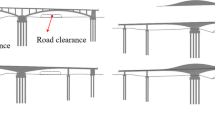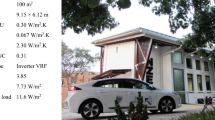Abstract
In many regions around the world, the empirical pavement design methods are the only pavement design choices available to pavement engineers. These empirical methods have several limitations. The Mechanistic–Empirical Pavement Design Guide (MEPDG) is the latest pavement design approach and is considered an advanced tool to provide a reliable and economic design. Due to its sophisticated and complex nature in terms of the need for a large amount of data input in addition to its constrained availability, the MEPDG is of limited usage in those regions. The main objective of this study is to initiate a procedure to create a flexible pavement design catalogue based on the MEPDG approach and in accordance with a region’s traffic loading, climate, and local material characteristics. This procedure consists of three different tasks. The first task is concerned with establishing the MEPDG data inputs from actual local roadway pavement materials and available regional traffic and environmental information, thence arranging these data inputs in the form of different design combinations. The second task is running the AASHTOware simulations for these different design combinations. The final task is the development of the mechanistic–empirical pavement design catalogue. For each design combination, the design case for which the predicted distresses are within the acceptable performance criteria is selected as a design solution. Accordingly, this research provides a procedure to develop a flexible pavement design catalogue using the MEPDG approach based on the regional conditions. The described approach was applied to the Egyptian pavements, for which a design catalogue is presented.








Similar content being viewed by others
References
ARA Inc (2004) ERES consultants division. Guide for Mechanistic–empirical design of new and rehabilitated pavement structures. NCHRP Project 1–37A transportation research board of the national academies. Washington, DC
Darter M (2006) NCHRP project 1-40D (02), technical assistance to NCHRP and NCHRP project 1–40A: Versions 0.9 and 1.0 of the ME pavement design software. Transportation Research Board, National Research Council, Washington, DC, http://www4.trb.org/trb/crp.nsf/AllProjects/NCHRP
Abdullah A (2012) Development of a flexible pavement design procedure based on the mechanistic-empirical pavement design guide: a case study, Master thesis, the University of Texas at Arlington. http://hdl.handle.net/10106/11530.
AASHTOWare pavement ME design. https://me-design.com/MEDesign/?AspxAutoDetectCookieSupport=1
Xiao et al (2011) Mechanistic-empirical pavement design guide (MEPDG): a bird’s-eye view. J Mod Transp 19:114–133
Boone J (2013) Comparison of Ontario pavement designs using the AASHTO 1993 empirical method and the mechanistic-empirical pavement design guide method. Master Thesis, University of Waterloo, Ontario
El-Badawy S, Bayomy F, Santi M, Clawson C (2011) Comparison of Idaho pavement design procedure with AASHTO 1993 and MEPDG Methods. proceedings of the first integrated transportation and development institute Congress. In: Al-Qadi I, Murrell S (eds) Published by the American Society of Civil Engineers, Chicago, Illinois, USA, 13–16 March, pp 586–595
Bayomy F, El-Badawy S, Awed A (2012) Implementation of the MEPDG for Flexible Pavements in Idaho, (Report No. FHWA-ID-12–193). ITD Project RP 193, NIATT Project KLK557. National Institute for Advanced Transportation Technology, University of Idaho, Moscow, Idaho: US
El-Badawy S, Bayomy F, Santi M (2012) Regional calibration of the MEPDG rutting models – Idaho Case Study, 10th international congress on advances in civil engineering. Middle East Technical University, Ankara, Turkey
Darter M, Titus-Glover L, Von Quintus H (2009) Implementation of the mechanistic-empirical pavement design Guide in Utah: validation, calibration, and development of the UDOT MEPDG User’s Guide (Report No. UT-09.11). Utah: US
Von Quintus H, Moulthrop J (2007) Mechanistic-empirical pavement design guide flexible pavement performance prediction models for Montana: Volume I Executive Research Summary (FHWA/MT-07-008/8158-1). Montana: US
Li J, Pierce L, Uhlmeryer J (2009) Calibration of flexible pavement in mechanistic-empirical pavement design guide for Washington State. Transportation research board, journal of the transportation research board, No. 2095, pp 73–83. Washington, DC: US
Souliman M (2009) Calibration of the AASHTO MEPDG for flexible pavements for Arizona Conditions. Master’s Thesis, Arizona State University, Tempe, AZ: U.S.
Hall K, Xiao D, Wang K (2011) Calibration of the MEPDG for Flexible Pavement Design in Arkansas. Paper No. 11-3562, TRB 90th Annual Meeting Compendium of Papers CD-ROM. Washington, DC: US
El-Badawy S, Bayomy F, Fugit S (2012) Traffic characteristics and their impact on pavement performance for the implementation of the mechanistic-empirical pavement design guide in Idaho. Int J Pavement Res Technol IJPRT 5(6):386–394
Haj Chhade R, Mrad R, Houssami L, Chehab G (2018) Formulation of traffic inputs required for the implementation of the ME PDG in data-scarce regions: Lebanon case study. J Mater Civ Eng 30(9):04018198
Kim S, Ceylan H, Heitzman M (2005) Sensitivity study of design input parameters for two flexible pavement systems using the mechanistic-empirical pavement design guide. In: Proceedings of the Mid- Continent Transportation Research Symposium, Ames, Iowa
Mohammad LN, Kim M, Raghavendra A, Obulareddy S (2014) Characterization of Louisiana asphalt mixtures using simple performance tests and MEPDG. Louisiana Transportation Research Center. https://www.semanticscholar.org/paper/Characterization-of-Louisiana-Asphalt-Mixtures-Mohammad-Saadeh/4d3ace4da7df7655fb23bc90fcfdf5928daf774f
El-Badawy S (2012) Recommended changes to designs not meeting criteria using the M-E pavement design guide. Int J Pavement Res Technol 5(1):54–61
Alqaili AH, Alsoliman HA (2017) Preparing data for calibration of mechanistic-empirical pavement design guide in central Saudi Arabia. Int J Civ Environ Struct Constr Archit Eng 11(2):248–255
Sadek HA, Masad EA, Sirin O, Al-Khalid H, Sadeq MA, Little D (2014) Implementation of mechanistic-empirical pavement analysis in the State of Qatar. Int J Pavement Eng 15(6):495–511. https://doi.org/10.1080/10298436.2013.837164
Chehab GR, Chehade RH, Houssami L, Mrad R (2017) Implementation initiatives of the mechanistic-empirical pavement design guide in countries with insufficient design input data: The case of Lebanon. In Proceedings of the international congress and exhibition sustainable civil infrastructures: innovative infrastructure geotechnology, 147–167. Springer, Cham, Switzerland
Bayomy F, Khedr SA (2010) Dynamic characterization of Egyptian Hot mix asphalt concrete for highway pavement design and evaluation, NIATT Project No KLK478 2014. University of Idaho, Moscow
American Association of State Highway and Transportation Officials AASHTO guide for design of pavement structures, 1993
El-shaib MS et al (2017) Comparison of AASHTO 1993 and MEPDG considering the Egyptian climatic conditions. Innov Infrastruct Solut. https://doi.org/10.1007/s41062-017-0067-6
El-Badawy S, Bayomy F, Santi M, Clawson C (2011) Comparison of Idaho pavement design procedure with AASHTO 1993 and MEPDG method. In: Al-Qadi I, Murrell S (eds) Proceedings of the first integrated transportation and development institute congress, Published by the American Society of Civil Engineers, Chicago, Illinois, USA, 13–16 March, pp 586–595
Aguib A, Khedr S (2016) The mechanistic-empirical pavement design: an egyptian perspective. functional pavement design – Erkens et al. (Eds)© 2016 Taylor & Francis Group, London, ISBN 978-1-138-02924-8 - CAT# K27629
Egyptian Code for Rural and Urban Roads Construction EC (2008)
Maupin GW, David Jr, Mokarem W (2006) Investigation of proposed AASHTO rut test procedure using the asphalt pavement analyzer. final, Virginia: Virginia Transportation Research Council. http://www.virginiadot.org/vtrc/main/online_reports/pdf/07-r11.pdf
Khedr SA, Saudy MM, Khafagy M (2014) Development of asphalt binder performance grades for Egypt. The Second Australasia and South East Asia structural engineering and construction conference (ASEA-SEC-2), Sustainable solutions in structural engineering and construction, pp393–398, Bangkok, Thailand
Wagdy E (2019) Performance characteristics and economic study of bituminous concrete using different industrial wastes as filler. Master thesis, Mansoura University, Mansoura
Saudy MM, Khedr SA (2016) Evaluation of normal and modified egyptian asphalt according to conventional and modern grading systems. The First European and mediterranean structural engineering and construction conference (EURO-MED-SEC-1), Istanbul, Turkey
Acknowledgements
The publication was supported by the American University in Cairo (AUC) faculty support grants.
Funding
The research leading to these results received funding from the American University in Cairo (AUC) faculty support grants under Grant Agreement No. (SSE-CENG-M.S-FY20-FY21-RG(1-20)-2019-Sep-28-09-16-18).
Author information
Authors and Affiliations
Ethics declarations
Conflict of interest
On behave of all authors, the corresponding author states that there is no conflict of interest.
Rights and permissions
About this article
Cite this article
Saudy, M., Breakah, T., El-Badawy, S. et al. Development of a flexible pavement design catalogue based on mechanistic–empirical pavement design approach: Egyptian case study. Innov. Infrastruct. Solut. 6, 206 (2021). https://doi.org/10.1007/s41062-021-00573-2
Received:
Accepted:
Published:
DOI: https://doi.org/10.1007/s41062-021-00573-2




